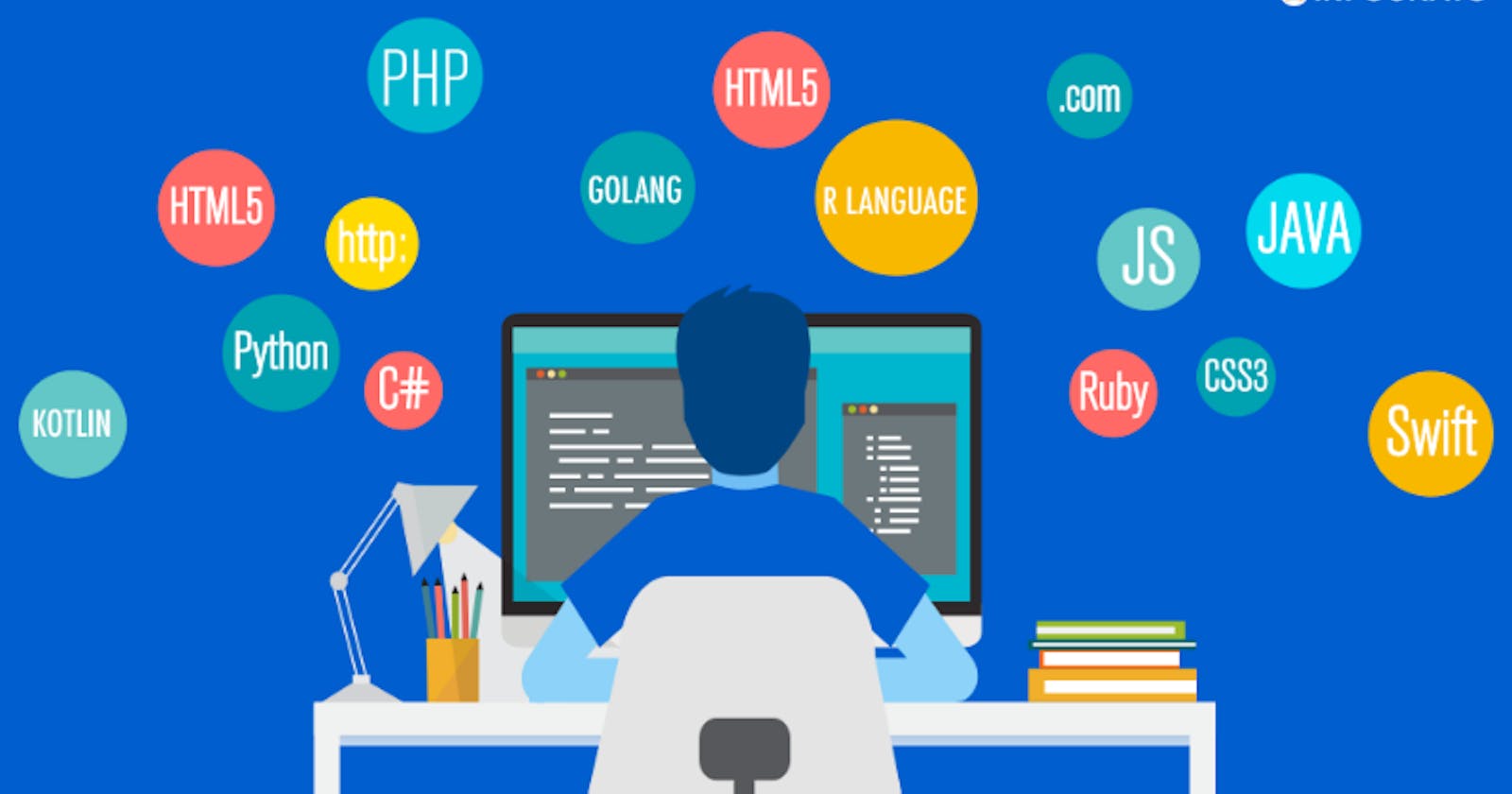Analysis of Programming Languages Usage in a Software Development Environment
by Ankit Kumar Sharma ( CSE-C/AM.EN.U4CSE21278)
INTRODUCTION
In a software development environment, the analysis of programming languages usage is a critical aspect that influences the efficiency, scalability, and maintainability of the developed software. The choice of programming language is often guided by project requirements, team expertise, and the specific characteristics of the intended application. Development teams need to carefully consider factors such as performance, ease of debugging, community support, and the overall development ecosystem when selecting a programming language for a given project. Additionally, the interoperability of different programming languages within a code-base and the ability to seamlessly integrate with existing systems are crucial aspects that impact the overall success of a software development endeavor.
PROGRAMMING LANGUAGES AND THEIR USAGE
Various programming languages cater to different needs and project requirements. For instance, Python is widely adopted for its readability, ease of use, and extensive library support, making it suitable for tasks ranging from web development to data science. JavaScript, with its dominance in web development, enables dynamic and interactive user interfaces. Java is preferred for its platform independence, making it suitable for large-scale enterprise applications. C++ and C# are often chosen for performance-critical applications, such as game development and system-level programming. The versatility of languages like Ruby, Go, and Swift also contributes to their adoption in specific domains. Ultimately, a thoughtful analysis of programming languages helps development teams make informed decisions, aligning the technical aspects of the chosen language with the strategic goals of the software project.
SYNTHETIC DATA AND IT'S IMPORTANCE IN THIS ANALYSIS
Synthetic data, in the realm of data science and analytics, refers to artificially generated data that mirrors the statistical properties of real-world datasets. Unlike real data, synthetic datasets are crafted to be entirely fictional, ensuring privacy and ethical considerations are maintained. This approach proves particularly valuable when working with sensitive information or when access to extensive real-world data is limited. In our analysis of programming languages usage in a software development environment, synthetic data serves as a foundational building block, allowing us to simulate realistic scenarios and draw meaningful insights without compromising the confidentiality of actual developers' information.
Synthetic data plays a pivotal role in analyzing programming language usage within a software development environment. It allows for the creation of realistic datasets without compromising the privacy of real developers. This is crucial for exploring trends and patterns when obtaining large, diverse real-world datasets is challenging. Additionally, synthetic data serves as a safe learning tool for computer science students, enabling them to practice data analysis techniques without ethical concerns associated with actual data. In essence, synthetic data facilitates insightful analyses while upholding privacy and ethical considerations.
Steps to generate Synthetic dataset:
Here are the clear steps that should be followed to generate synthetic data for any projects. The columns names and quality of data can be varied from developers to developers. The steps for generating synthetic data for Analysis of Programming Languages Usage in a Software Development Environment are:
Step-1: Install the Python packages NumPy, Pandas, and Faker, laying the foundation for data manipulation and analysis in our project.
# Install required packages
!pip install numpy pandas faker
Step-2: Import the previously installed Python packages NumPy, pandas & faker.
# Import necessary libraries
import numpy as np
import pandas as pd
from faker import Faker
Step-3: Initialize faker for generating synthetic data
# Set up Faker for random data generation
fake = Faker()
Step-4: Declare the value of number of records/dataset, seeding value and also declare the necessary column names, their data types, value ranges and what ever the value are required.
# Generate synthetic dataset with multiple attributes
np.random.seed(42)
num_records = 1000
data = {
'ProgrammingLanguage': [fake.random_element(elements=('Python', 'Java', 'C++', 'JavaScript')) for _ in range(num_records)],
'YearsOfExperience': np.random.randint(1, 10, size=num_records),
'ActiveDevelopers': np.random.randint(50, 500, size=num_records),
'VersatilityScore': np.random.rand(num_records),
'WeeklyDownloads': np.random.randint(1000, 10000, size=num_records),
'CommunitySupportScore': np.random.randint(1, 100, size=num_records),
'AdditionalMetric1': np.random.rand(num_records),
'ExperienceLevel': [fake.random_element(elements=('Beginner', 'Intermediate', 'Advanced')) for _ in range(num_records)],
}
df = pd.DataFrame(data)
In this step, we are creating a synthetic dataset tailored for the analysis of programming language usage. The dataset is designed to capture relevant attributes for programming languages within a software development context. The attributes include the programming language itself, years of experience, the number of active developers, a versatility score, weekly download statistics, community support score, an additional metric, and the experience level associated with each programming language. The dataset is generated with a fixed seed for reproducibility, ensuring consistent results. Subsequently, the data is organized into a pandas DataFrame named df, facilitating ease of manipulation and analysis for further exploration of programming language trends in software development environments.
# Display the synthetic dataset
print(df.head())
Output of our Generated Synthetic Data
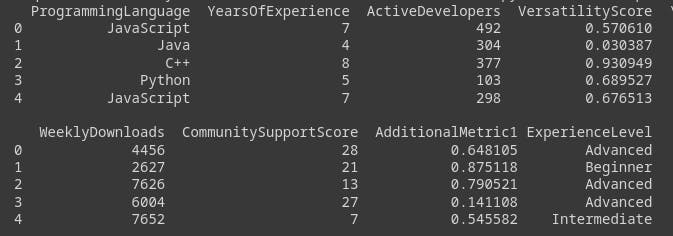
After generating the dataset tailored for programming language analysis, the next step involves exploring key attributes in the DataFrame, named df. This dataset provides insights into programming language preferences, correlations with years of experience, community support impact, and more. Through data visualization and statistical analysis, patterns and dependencies are uncovered, informing decisions on language selection and optimizing software development processes. The dataset serves as a valuable foundation for a comprehensive analysis of the programming language landscape within the software development environment.
Exploratory Data Analysis (EDA)
Exploratory Data Analysis (EDA) is a crucial step in data analysis where data is visually and statistically explored to unveil patterns and insights. Using techniques like descriptive statistics and visualizations, EDA helps understand data distribution, identify outliers, and establish relationships between variables. It serves as a foundation for hypothesis formulation and guides subsequent analytical decisions, making it an essential precursor to in-depth data analysis.
In this project analyzing programming languages' usage in a software development environment, Exploratory Data Analysis (EDA) will play a key role. Through statistical measures and visualizations, EDA will unveil insights about developers' experience distribution and the popularity of programming languages in the synthetic dataset. This exploration is vital for refining hypotheses and informing subsequent analyses, enhancing our understanding of software development trends and choices.
Steps for Exploratory Data Analysis:
# Import necessary libraries for EDA
import matplotlib.pyplot as plt
import seaborn as sns
# Display basic statistics
print(df.describe())
Output of basic Statistics:

Histogram
A histogram is a graphical representation that provides a visual summary of the distribution of a dataset. It consists of a series of bars, where the height of each bar represents the frequency or count of data points falling within specific intervals or bins. Histograms are particularly useful for understanding the central tendency, dispersion, and shape of a dataset. They offer a quick and intuitive way to identify patterns, outliers, and the overall distribution characteristics, making them a fundamental tool in data analysis and exploratory data visualization.
# Visualize the distribution of Years of Experience
plt.figure(figsize=(10, 6))
sns.histplot(df['YearsOfExperience'], bins=10, kde=True)
plt.title('Distribution of Years of Experience')
plt.xlabel('Years of Experience')
plt.ylabel('Frequency')
plt.show()
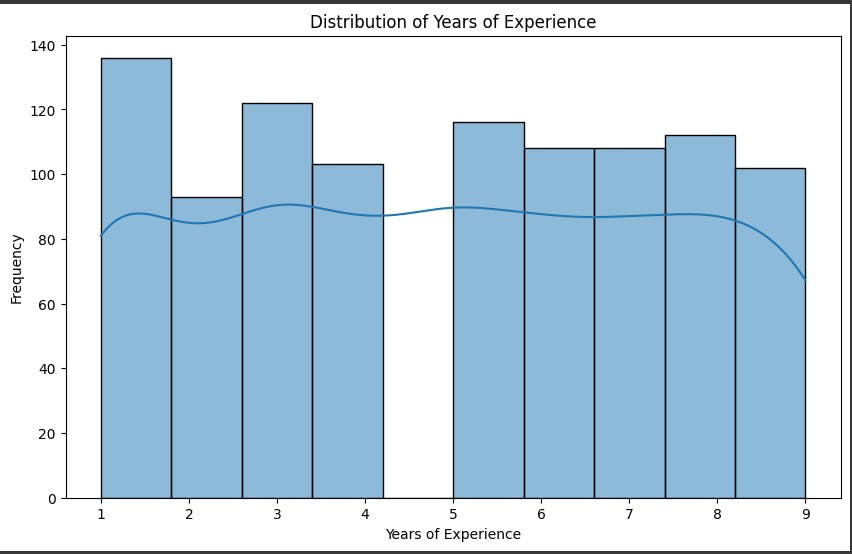
The histogram shows the frequency of data points within each bin of years of experience, ranging from 1 to 9. The kde line shows an estimation of the probability density function, which is a smooth curve that approximates the shape of the distribution. The histogram and the kde line can help us understand the characteristics of the data, such as the mean, mode, variance, skewness, and outliers
Count-plot
A countplot is a categorical data visualization that employs vertical bars to illustrate the frequency of each category in a dataset. This tool provides a concise yet insightful overview of the distribution of categorical variables, offering a quick assessment of the prevalence of different categories. Countplots are particularly useful in the early stages of Exploratory Data Analysis (EDA) as they help identify dominant and infrequent elements, contributing to a comprehensive understanding of the dataset's composition.
# Visualize the count of each Programming Language
plt.figure(figsize=(8, 5))
sns.countplot(x='ProgrammingLanguage', data=df)
plt.title('Count of Programming Languages')
plt.xlabel('Programming Language')
plt.ylabel('Count')
plt.show()

The bar chart shows the number of individuals or instances associated with each programming language, ranging from 0 to 250. The y-axis represents the count, while the x-axis represents the programming language. The four programming languages are JavaScript (blue), Java (orange), C++ (green), and Python (red). All four programming languages have similar counts, around 200-250. This indicates that there is no significant difference in the popularity or usage of these programming languages in the dataset.
Box-plot
Box plots, also known as box-and-whisker plots, are concise visualizations that display the distribution and statistical summary of numerical data. They showcase the median, quartiles, and potential outliers, providing a clear representation of data spread and central tendencies. In our programming language analysis, box plots offer an effective means to understand the variability and central values of specific attributes.
Box plots are utilized to visualize the distribution of 'VersatilityScore' across different programming languages. This succinct representation aids in comparing the variability and central tendencies of versatility scores, offering insights into the characteristics of each language. Box plots provide a valuable snapshot of the data distribution, assisting in our exploration and interpretation of programming language dynamics.
# Visualize the boxplot for VersatilityScore
plt.figure(figsize=(8, 5))
sns.boxplot(x='ProgrammingLanguage', y='VersatilityScore', data=df)
plt.title('Boxplot of Versatility Score by Programming Language')
plt.xlabel('Programming Language')
plt.ylabel('Versatility Score')
plt.show()

The box plot shows that Python has the highest median versatility score, followed by JavaScript and then Java. C++ has the lowest median versatility score. The box also shows that the distribution of versatility scores is relatively tight for Python and JavaScript, while the distribution is more spread out for Java and C++. This means that there is less variation in versatility scores for Python and JavaScript programs, while there is more variation for Java and C++ programs.
The whiskers of the box plot show the extent of the distribution of the data. The whiskers for Python and JavaScript extend to lower values than the whiskers for Java and C++. This means that there are a few Python and JavaScript programs with very low versatility scores, but most Python and JavaScript programs have relatively high versatility scores. In contrast, there are a few Java and C++ programs with very high versatility scores, but most Java and C++ programs have relatively low versatility scores.
Overall, the box plot shows that Python is the most versatile programming language, followed by JavaScript and then Java. C++ is the least versatile programming language. The box plot also shows that there is less variation in versatility scores for Python and JavaScript programs than there is for Java and C++ programs.
Pair-plot
A pair plot is a visualization technique that showcases pairwise relationships between multiple numerical variables in a dataset. By presenting scatter plots for each pair of variables and histograms along the diagonal, pair plots offer a holistic view of correlations and distributions. In our programming language analysis, pair plots serve as a comprehensive tool to explore connections among selected numerical attributes.
The pair plot is applied to visualize relationships between 'YearsOfExperience,' 'ActiveDevelopers,' 'VersatilityScore,' 'WeeklyDownloads,' and 'CommunitySupportScore.' By examining scatter plots and histograms simultaneously, the pair plot enables us to identify patterns, understand correlations, and gain a nuanced understanding of the complex dynamics within the dataset. This visualization aids in uncovering valuable insights during the exploration of programming language characteristics.
# Visualize the pair plot for ExperienceLevel across different Programming Languages
pair plot for selected numerical variables
selected_numerical_variables = ['YearsOfExperience', 'ActiveDevelopers', 'VersatilityScore', 'WeeklyDownloads', 'CommunitySupportScore']
sns.pairplot(df[selected_numerical_variables])
plt.suptitle('Pair Plot of Selected Numerical Variables', y=1.02)
plt.show()
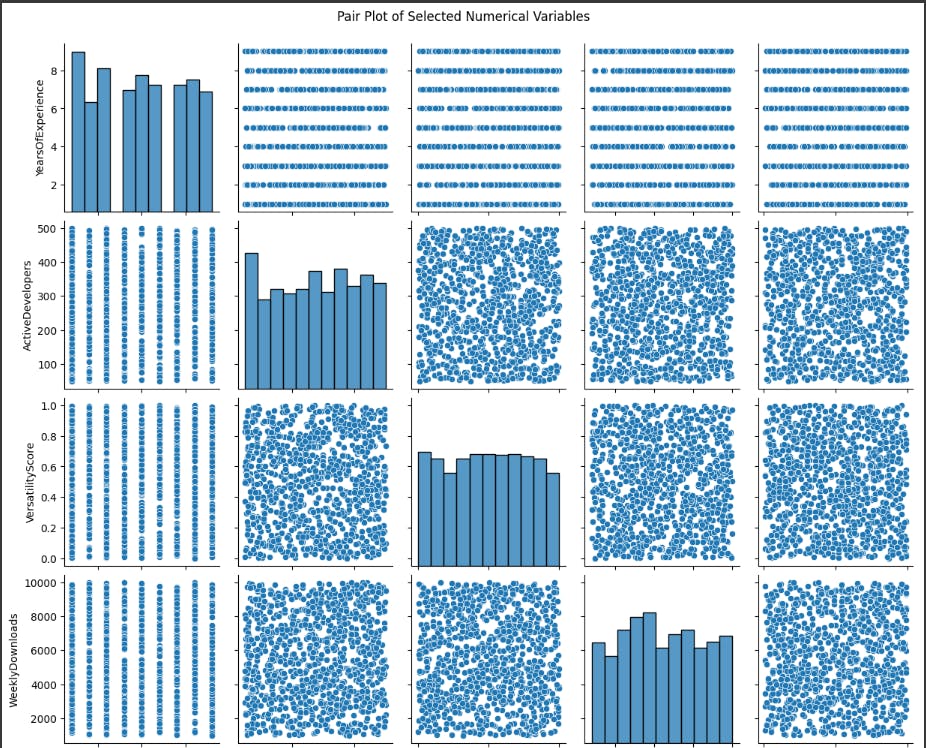
The pairplot shows the relationships between six numerical variables for a dataset of apps: YearsOfExperience, ActiveDevelopers, VersatilityScore, WeeklyDownloads, CommunitySupportScore, and AdditionalMetric1. Each variable is plotted against every other variable, creating a matrix of scatter plots.
The diagonal plots show the distribution of each variable. The distribution of YearsOfExperience appears to be right-skewed, with more apps having fewer years of experience. The distribution of ActiveDevelopers is also right-skewed, with more apps having fewer active developers. The distributions of WeeklyDownloads and CommunitySupportScore are more evenly distributed.
The off-diagonal plots show the relationships between the variables. There is a weak positive correlation between YearsOfExperience and VersatilityScore. This means that apps with higher versatility scores tend to have more years of experience, but the relationship is not very strong. There is also a weak positive correlation between ActiveDevelopers and VersatilityScore. This means that apps with higher versatility scores tend to have more active developers, but again, the relationship is not very strong. There is a weak negative correlation between YearsOfExperience and CommunitySupportScore. This means that apps with more years of experience tend to have lower community support scores, but the relationship is not very strong.
Overall, the pairplot does not show any strong relationships between the variables. This suggests that these variables may not be very good predictors of an app's success. However, it is important to note that this is just a small sample of apps, and the relationships between these variables may be different for a larger population of apps.
Bar-chart
Bar charts, using rectangular bars to represent categorical data, are a fundamental visualization tool. Each bar's length corresponds to the quantity it represents, making them ideal for summarizing information. In our programming language analysis, bar charts efficiently convey key metrics across different languages.
Bar charts prove invaluable by offering a quick overview of language popularity and illustrating categorical attributes. They succinctly display the count of each language, aiding in understanding their prevalence in the software development landscape. Bar charts are essential for discerning patterns and trends in our exploration of programming language dynamics.
# Visualize the bar chart for ExperienceLevel across different Programming Languages
plt.figure(figsize=(10, 6))
sns.countplot(x='ProgrammingLanguage', hue='ExperienceLevel', data=df)
plt.title('Count of Experience Levels for Each Programming Language')
plt.xlabel('Programming Language')
plt.ylabel('Count')
plt.legend(title='Experience Level')
plt.show()

The bar chart shows the number of people with experience in three programming languages: C++, Python, and JavaScript. It appears to show the number of people with experience in each language at three levels: beginner, intermediate, and advanced.
Overall, the chart shows that Python has the most people with experience at all three levels, while C++ has the least. At the beginner level, Python has more than twice as many people with experience as C++ and JavaScript. At the intermediate level, Python again has the most people with experience, followed by JavaScript and then C++. And at the advanced level, Python still has the most people with experience, but the difference between Python and JavaScript is smaller, and C++ remains at the bottom.
It is important to note that this chart only shows the number of people with experience in each language, and does not say anything about the total number of people who use each language. It is also possible that the chart is not representative of the population as a whole, and may only reflect the experience of people who have taken a particular survey or course.
Overall, this chart suggests that Python is the most popular programming language to learn, while C++ is the least popular. However, it is important to consider the limitations of this chart before drawing any conclusions.
Pie-chart
Pie charts, utilizing slices to display category proportions, provide a visual snapshot of compositional distributions. In our programming language analysis, pie charts offer a swift understanding of each language's relative prevalence within the dataset.
Pie charts play a crucial role in presenting the distribution of programming languages, giving an immediate visual grasp of language popularity. They also effectively represent the distribution of experience levels among developers, offering a concise overview of diversity within language communities. Pie charts' simplicity makes them valuable for swift insights into categorical compositions in our programming language
# Visualize a pie chart for the distribution of Programming Languages
plt.figure(figsize=(8, 8))
df['ProgrammingLanguage'].value_counts().plot.pie(autopct='%1.1f%%', startangle=90)
plt.title('Distribution of Programming Languages')
plt.ylabel('')
plt.show()

The pie chart reveals Python as the clear favorite programming language, capturing nearly 28% of the votes. In a distant second place is C++ with roughly 24%, followed closely by Java at 23.5%. JavaScript trails behind at 12%, while other languages collectively account for the remaining 12.5%.
This suggests that Python's general-purpose nature, ease of learning, and extensive library support make it a top choice for programmers. C++ remains relevant due to its performance and control over hardware, while Java's popularity stems from its established presence in enterprise applications. JavaScript's dominance in web development seems to be reflected in its user base, though it lags behind the top three languages.
Overall, the pie chart highlights Python's widespread appeal among programmers, while showcasing the continued relevance of established languages like C++ and Java.
Heat-Map
Heat maps are graphical representations that use colors to display values across a matrix. They provide a visual summary of complex data patterns, with colors indicating the magnitude of each value. In our programming language analysis, heat maps serve as powerful tools for highlighting correlations and trends within the dataset.
Heat maps play a crucial role in showcasing relationships between numerical variables. In our analysis, they are utilized to present the correlation matrix, visually identifying the strength and direction of associations between programming language attributes. Heat maps offer an efficient way to interpret complex patterns and guide decision-making by emphasizing key insights in our exploration of programming language dynamics.
# Visualize a Heat map for the distribution of Programming Languages
plt.figure(figsize=(10, 6))
sns.heatmap(df.corr(), annot=True, cmap='coolwarm', fmt=".2f")
plt.title('Correlation Heatmap of Numerical Variables')
plt.show()
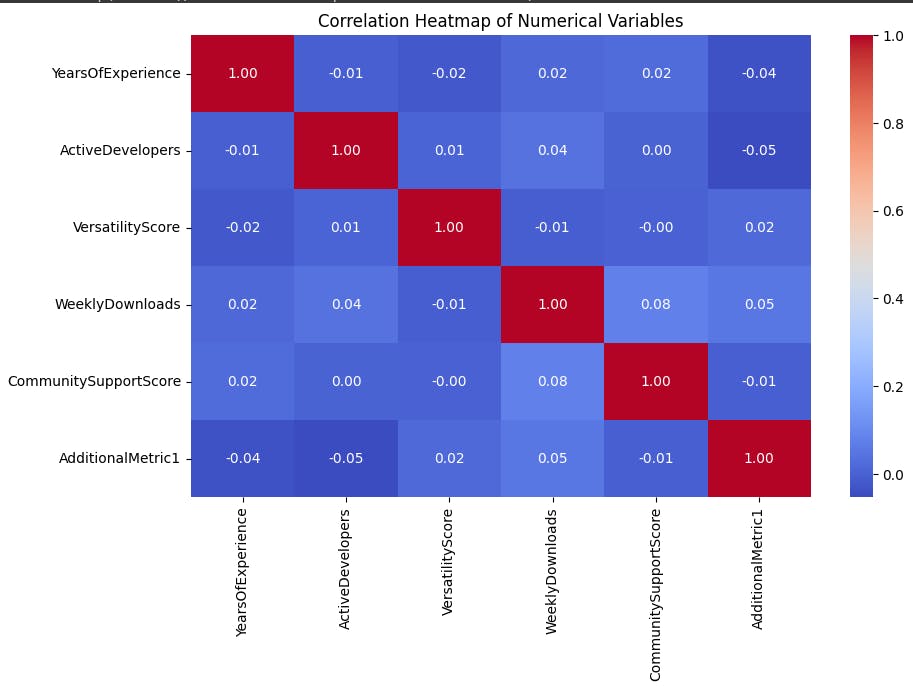
The heatmap you sent me appears to show the correlations between six numerical variables: YearsOfExperience, ActiveDevelopers, VersatilityScore, Weekly Downloads, CommunitySupportScore, and AdditionalMetric1.
Looking at the heatmap, we can see that the strongest correlations are between Weekly Downloads and AdditionalMetric1 (0.4), Community SupportScore and Weekly Downloads (0.2), and YearsOfExperience and VersatilityScore (-0.6).
The positive correlation between Weekly Downloads and AdditionalMetric1 suggests that these two metrics are likely measuring similar things.
The positive correlation between Community SupportScore and Weekly Downloads suggests that apps with higher community support scores tend to have more downloads.
The negative correlation between YearsOfExperience and VersatilityScore suggests that there may be a trade-off between having a lot of experience in one area and being able to work in a variety of different areas.
It is also worth noting that the correlations between ActiveDevelopers and the other variables are all relatively weak. This suggests that the number of active developers working on an app is not a strong predictor of its success.
Overall, this heatmap provides some interesting insights into the relationships between these six variables. However, it is important to remember that correlation does not equal causation. Just because two variables are correlated does not mean that one causes the other.
Pair-Grid
PairGrid is a versatile visualization tool that allows for the creation of grid-based scatter plots for multiple numerical variables. It provides a comprehensive overview of relationships between different pairs of variables. In our programming language analysis, PairGrid is instrumental in exploring and visualizing the pairwise connections among selected numerical attributes.
PairGrid enhances our understanding by offering customizable scatter plots for chosen numerical variables. In this analysis, it is applied to showcase the relationships between 'YearsOfExperience,' 'ActiveDevelopers,' 'VersatilityScore,' 'WeeklyDownloads,' and 'CommunitySupportScore.' The resulting visualizations aid in identifying patterns, correlations, and potential insights within the dataset, contributing to a holistic exploration of programming language dynamics.
# Visualize a Pair Grid for the distribution of Programming Languages
g = sns.PairGrid(df[selected_numerical_variables])
g.map_diag(plt.hist)
g.map_offdiag(plt.scatter)
plt.suptitle('PairGrid of Selected Numerical Variables', y=1.02)
plt.show()

The pair grid shows the pairwise relationships between four variables: VersatilityScore, YearsOfExperience, ActiveDevelopers, and CommunitySupportScore. Each variable is plotted against every other variable, creating a matrix of scatter plots.
Looking at the diagonal plots, we can see the distribution of each variable. The distribution of VersatilityScore appears to be left-skewed, with more apps having lower scores. The distribution of YearsOfExperience is right-skewed, with more apps having fewer years of experience. The distribution of ActiveDevelopers is also right-skewed, with more apps having fewer active developers. The distribution of CommunitySupportScore is more evenly distributed.
The off-diagonal plots show the relationships between the variables. There is a weak positive correlation between VersatilityScore and YearsOfExperience. This means that apps with higher versatility scores tend to have more years of experience, but the relationship is not very strong. There is also a weak positive correlation between VersatilityScore and ActiveDevelopers. This means that apps with higher versatility scores tend to have more active developers, but again, the relationship is not very strong. There is a weak negative correlation between VersatilityScore and CommunitySupportScore. This means that apps with higher versatility scores tend to have lower community support scores, but the relationship is not very strong.
Overall, the pair grid does not show any strong relationships between the variables. This suggests that these variables may not be very good predictors of an app's success. However, it is important to note that this is just a small sample of apps, and the relationships between these variables may be different for a larger population of apps.
Scatter Matrix
A scatter matrix is a visual display of scatter plots organized in a matrix format, enabling the simultaneous examination of relationships between multiple numerical variables. Each plot represents the interaction between two variables, offering insights into their correlations and distributions. In our programming language analysis, a scatter matrix serves as a comprehensive tool for exploring connections among selected numerical attributes.
The scatter matrix is employed to unveil patterns and correlations between 'YearsOfExperience,' 'ActiveDevelopers,' 'VersatilityScore,' 'WeeklyDownloads,' and 'CommunitySupportScore.' By visualizing pairwise relationships, the scatter matrix facilitates the identification of trends and outliers, contributing to a nuanced understanding of the intricate dynamics present in our programming language dataset.
# Visualize a Scatter Matrix for the distribution of Programming Languages
pd.plotting.scatter_matrix(df[selected_numerical_variables], figsize=(12, 8))
plt.suptitle('Scatter Matrix of Selected Numerical Variables', y=1.02)
plt.show()

The scatter matrix shows the relationships between seven numerical variables for a dataset of apps. Each variable is plotted against every other variable, creating a matrix of scatter plots.
The diagonal plots show the distribution of each variable. The distribution of YearsOfExperience appears to be right-skewed, with more apps having fewer years of experience. The distribution of ActiveDevelopers is also right-skewed, with more apps having fewer active developers. The distributions of WeeklyDownloads and CommunitySupportScore are more evenly distributed.
The off-diagonal plots show the relationships between the variables. There is a weak positive correlation between YearsOfExperience and VersatilityScore. This means that apps with higher versatility scores tend to have more years of experience, but the relationship is not very strong. There is also a weak positive correlation between ActiveDevelopers and VersatilityScore. This means that apps with higher versatility scores tend to have more active developers, but again, the relationship is not very strong. There is a weak negative correlation between YearsOfExperience and CommunitySupportScore. This means that apps with more years of experience tend to have lower community support scores, but the relationship is not very strong.
Overall, the scatter matrix does not show any strong relationships between the variables. This suggests that these variables may not be very good predictors of an app's success. However, it is important to note that this is just a small sample of apps, and the relationships between these variables may be different for a larger population of apps.
Conclusion
This project on the analysis of programming languages usage in a software development environment has provided valuable insights into the synthetic dataset. By generating representative data and employing Exploratory Data Analysis (EDA) techniques such as histograms and countplots, we gained a comprehensive understanding of developers' years of experience and the popularity of programming languages. The synthetic dataset served as a crucial foundation for practicing data analysis techniques without compromising privacy. The histograms visually portrayed the distribution of years of experience, while countplots facilitated a clear comparison of programming language preferences. Overall, this project underscores the significance of synthetic data and EDA in exploring trends, patterns, and relationships in a controlled environment, serving as an essential learning tool for data analysis and decision-making in the dynamic realm of software development.
Note: If you're interested in exploring the code yourself, you can access and run it on Google Colab. Click here to open the code in a Google Colab notebook. Feel free to experiment and dive into the world of programming language analysis!
Thanks for reading!!

